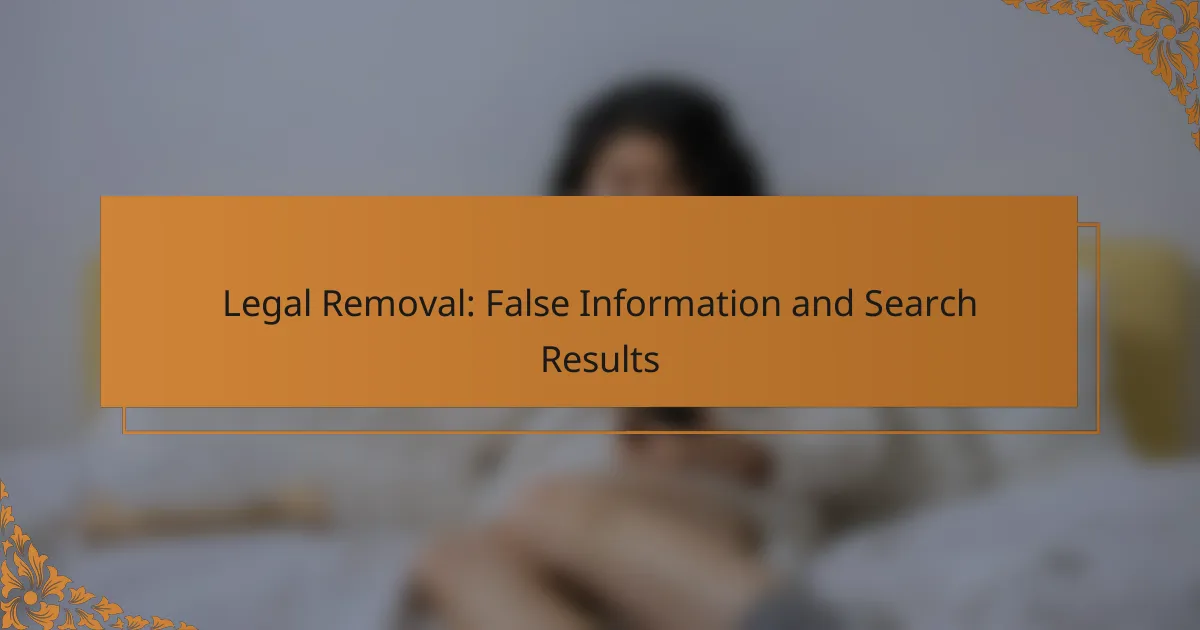Removing false information from search results in the UK involves various strategies, such as contacting search engines, seeking legal help, or filing complaints with regulatory bodies. Legal avenues like defamation claims and data protection actions can also be pursued, each with specific requirements. Additionally, the Digital Services Act (DSA) imposes stricter obligations on digital platforms, enhancing their responsibility to address misleading content effectively.
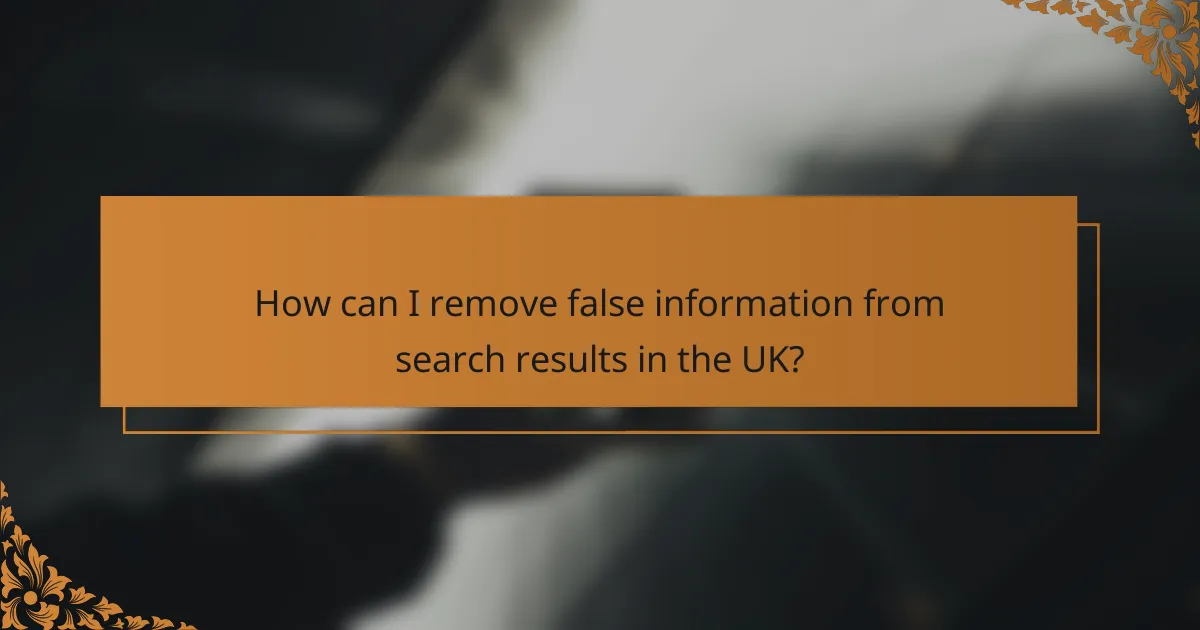
How can I remove false information from search results in the UK?
To remove false information from search results in the UK, you can take several steps, including contacting search engines directly, seeking legal assistance, or filing a complaint with regulatory bodies. Each method has its own process and effectiveness, so consider your options carefully.
Contact Google for removal
Google provides a process for requesting the removal of false information from its search results. You can submit a request through their support page, detailing the inaccuracies and providing evidence to support your claim.
Be prepared to explain why the information is false and how it affects you. Google typically reviews these requests, but the outcome can vary based on their policies and the nature of the content.
Utilize legal services
If the false information is damaging, consulting with a legal professional may be beneficial. Lawyers specializing in defamation or privacy law can guide you through the process of addressing false claims, which may include sending cease-and-desist letters or pursuing legal action.
Legal services can be costly, but they may be necessary for severe cases where reputational harm is significant. Weigh the potential benefits against the costs before proceeding.
Submit a complaint to the Information Commissioner’s Office
The Information Commissioner’s Office (ICO) oversees data protection and privacy in the UK. If false information violates your rights under data protection laws, you can file a complaint with the ICO.
When submitting a complaint, provide detailed information about the false content and how it breaches your rights. The ICO will investigate and may take action if they find your complaint valid.
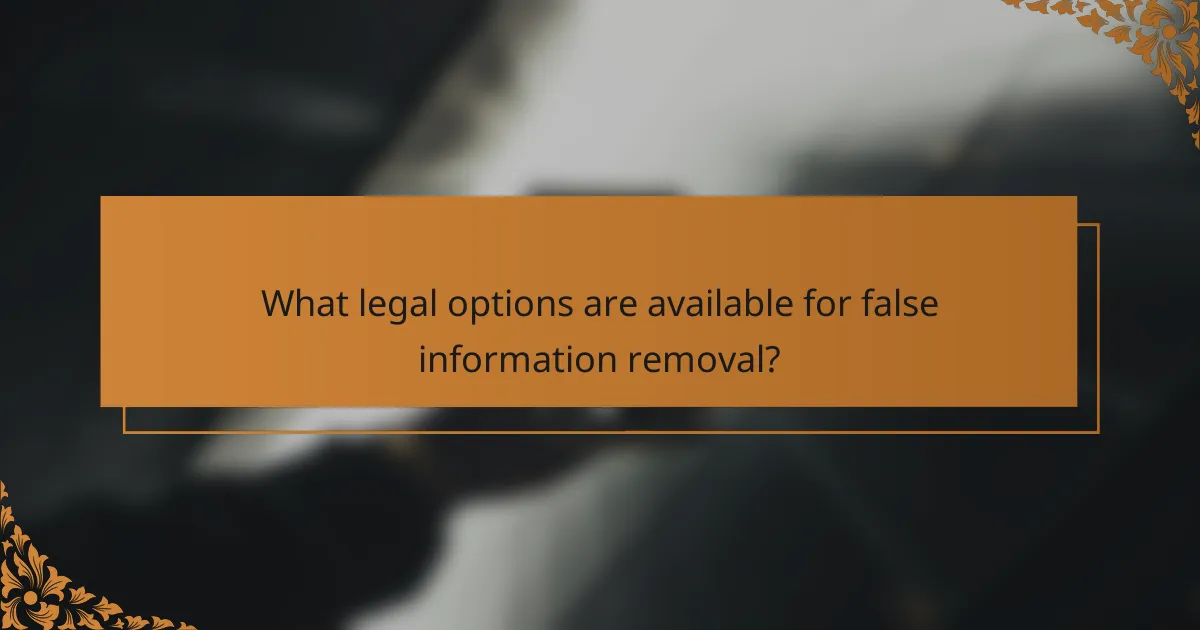
What legal options are available for false information removal?
Individuals and organizations can pursue several legal options to remove false information from search results, including defamation claims, data protection claims, and injunctions against publication. Each option has specific requirements and processes that must be followed to effectively address the issue.
Defamation claims
Defamation claims are legal actions taken when false statements harm a person’s reputation. To succeed, the claimant must prove that the information is false, damaging, and published with negligence or malice. In the U.S., for example, public figures face a higher burden of proof compared to private individuals.
Consider documenting evidence of the false information and its impact on your reputation. This may include witness statements, social media screenshots, or financial records showing loss of income. Consulting with a legal professional can help determine the viability of a defamation claim.
Data protection claims
Data protection claims arise when false information violates privacy rights under laws such as the General Data Protection Regulation (GDPR) in Europe. Individuals can request the removal of inaccurate personal data from online platforms if it does not comply with data protection standards.
To initiate a data protection claim, gather evidence of the inaccurate information and submit a request to the data controller or search engine. Be aware of the deadlines for filing claims, as they can vary by jurisdiction, often ranging from a few weeks to several months.
Injunctions against publication
An injunction against publication is a court order that prevents the dissemination of false information. This legal remedy is often sought in urgent situations where the continued publication could cause irreparable harm. The claimant must demonstrate that the information is false and that publication poses a significant risk.
When considering an injunction, it is crucial to act quickly, as delays can undermine the case. Prepare to present compelling evidence to the court, and consult with a legal expert to navigate the complexities of the injunction process effectively.
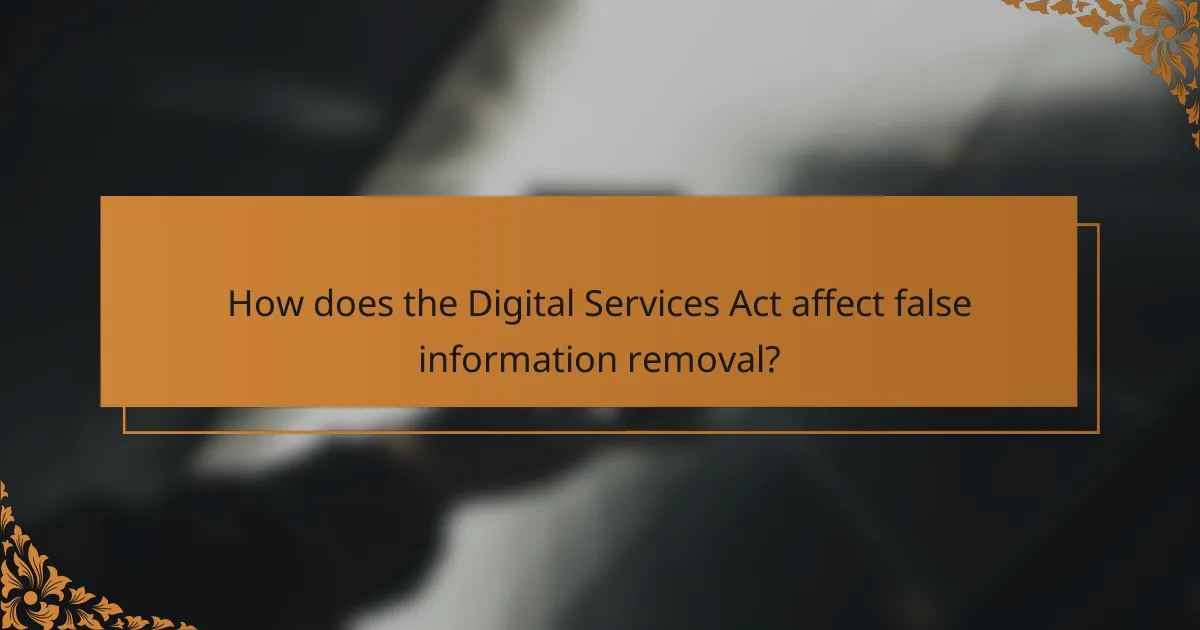
How does the Digital Services Act affect false information removal?
The Digital Services Act (DSA) enhances the framework for removing false information online by imposing stricter obligations on digital platforms. It requires these platforms to take greater responsibility for the content they host, ensuring that false or misleading information is addressed more effectively.
Increased accountability for platforms
The DSA mandates that online platforms must implement measures to detect and remove false information proactively. This includes establishing clear processes for identifying harmful content and providing transparency about their moderation practices.
Platforms are now required to report on their efforts to combat misinformation, which increases accountability. Failure to comply can result in significant penalties, including fines that can reach up to 6% of a company’s global revenue.
Enhanced user rights for content removal
Under the DSA, users have improved rights to request the removal of false information that affects them. This includes a clear mechanism for users to appeal decisions made by platforms regarding content moderation.
Users can expect faster responses to their requests, with platforms obligated to act within a specified timeframe. This shift empowers individuals to take action against misinformation that could harm their reputation or well-being.
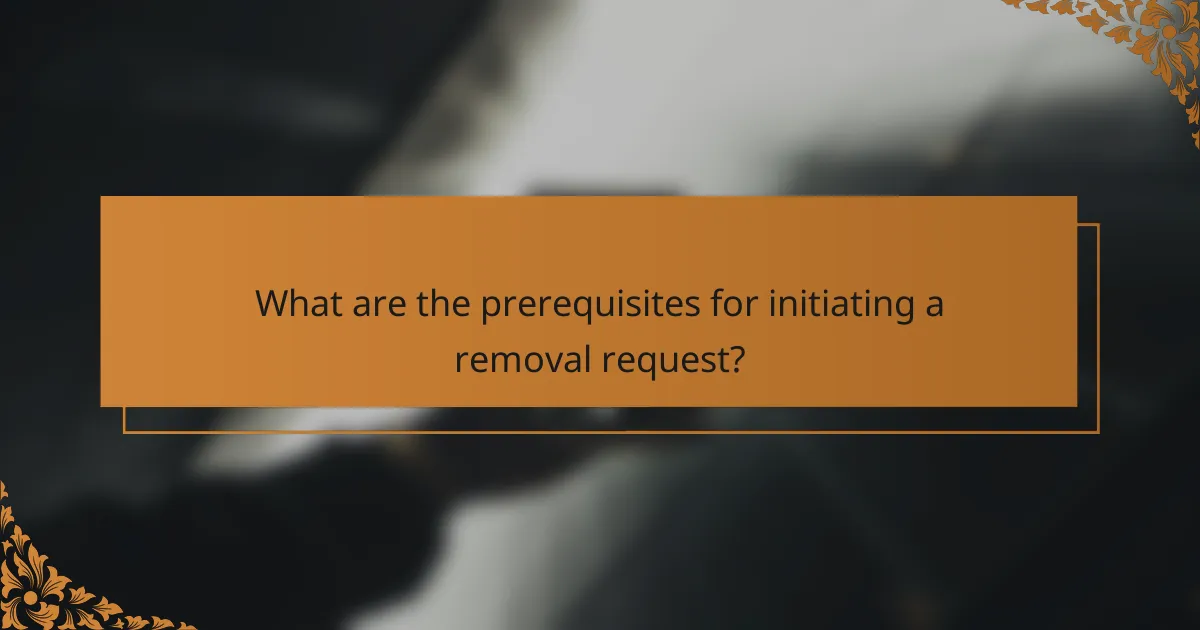
What are the prerequisites for initiating a removal request?
To initiate a removal request for false information, you must first gather sufficient evidence that the information is indeed false and identify the platform where it appears. Understanding the specific requirements of the platform can streamline the process and increase the chances of a successful request.
Gather evidence of false information
Collecting evidence is crucial for substantiating your claim of false information. This may include screenshots, links to credible sources, or official documents that contradict the false claims. Ensure that your evidence is clear and well-organized to facilitate the review process.
Consider creating a timeline of events or a summary document that outlines the inaccuracies and their impact. This can help present your case more effectively to the platform’s review team.
Identify the responsible platform
Determining the platform responsible for hosting the false information is essential for filing your removal request. This could be a social media site, a search engine, or a specific website. Each platform has its own policies and procedures for handling such requests.
Visit the help or support section of the platform to familiarize yourself with their guidelines on reporting false information. Some platforms may require you to fill out specific forms or provide additional documentation, so be prepared to follow their instructions closely.
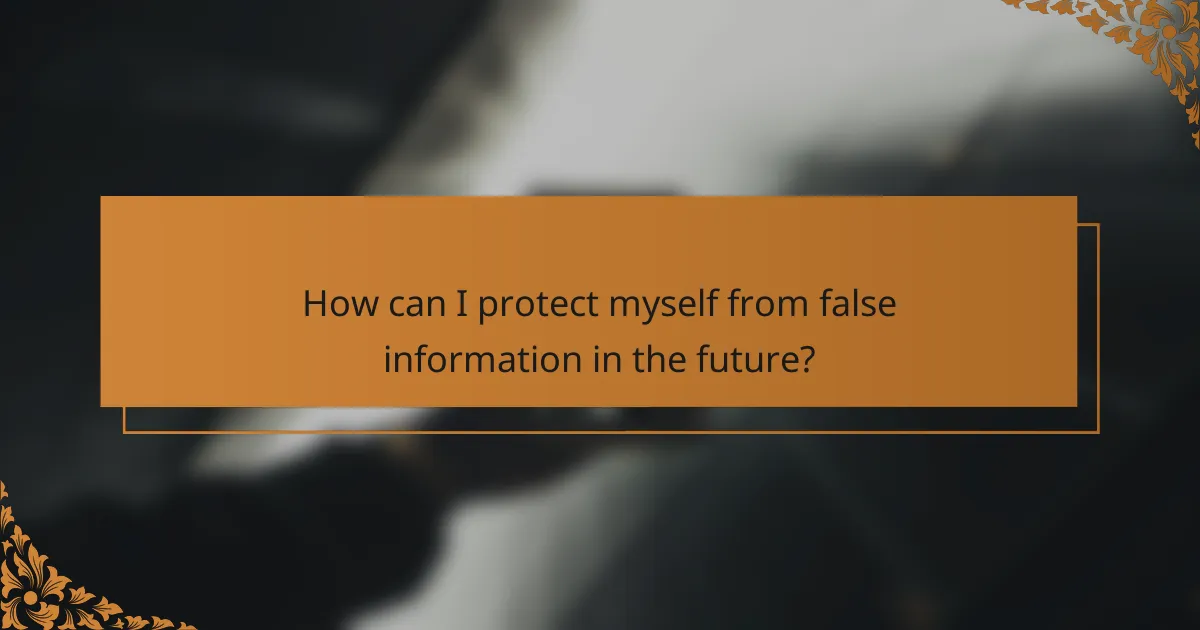
How can I protect myself from false information in the future?
To protect yourself from false information, regularly monitor your online presence and consider using reputation management services. These proactive steps can help you identify and address misleading content before it impacts your reputation.
Monitor online presence regularly
Regularly checking your online presence allows you to spot false information quickly. Set up Google Alerts for your name or brand to receive notifications about new mentions, making it easier to track what is being said.
Use social media monitoring tools to keep tabs on various platforms. These tools can help you identify negative comments or misinformation that could affect your reputation.
Utilize reputation management services
Reputation management services can assist in cleaning up false information and improving your online image. These services often include search engine optimization (SEO) strategies to push down negative content in search results.
When choosing a reputation management service, consider their track record and the specific strategies they employ. Look for companies that provide transparent reporting and measurable results, ensuring you can see the impact of their efforts.
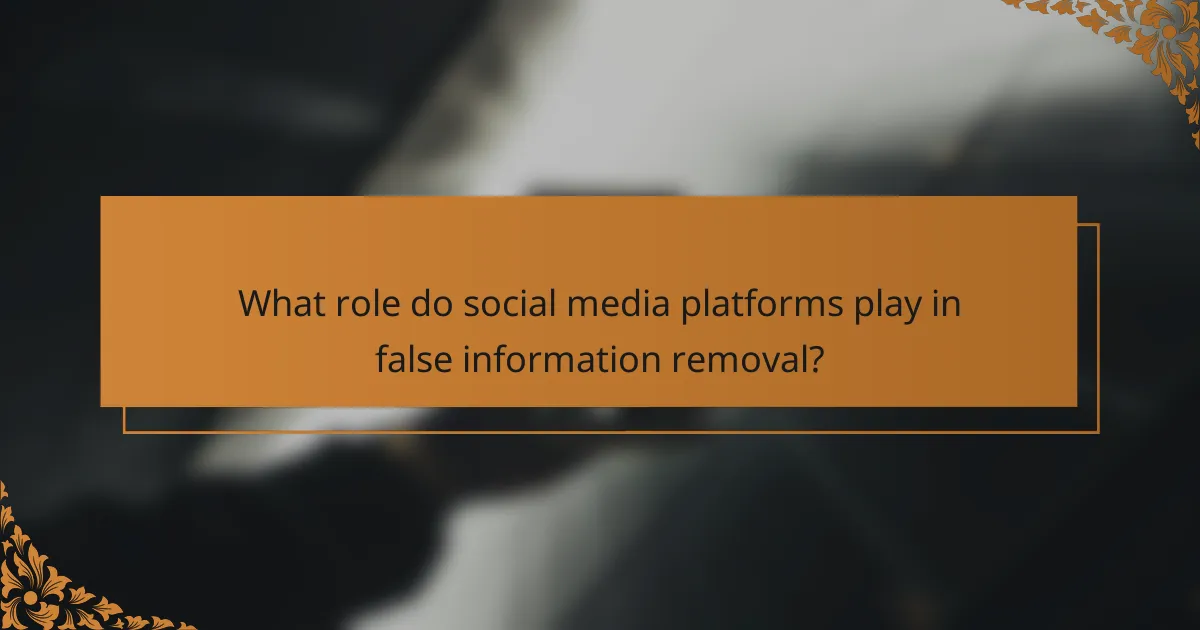
What role do social media platforms play in false information removal?
Social media platforms are crucial in identifying and removing false information to maintain user trust and safety. They implement various strategies, including content moderation and user reporting, to address misinformation effectively.
Content moderation policies
Content moderation policies outline how social media platforms manage and regulate user-generated content. These policies typically include guidelines on what constitutes false information, such as misleading claims or fabricated news articles. Platforms may employ a combination of automated systems and human reviewers to enforce these rules.
For example, platforms like Facebook and Twitter have specific policies that prohibit the sharing of false health information, especially during crises like pandemics. Violations can lead to content removal, account suspension, or even permanent bans.
User reporting mechanisms
User reporting mechanisms allow individuals to flag content they believe is false or misleading. Most platforms provide straightforward options for users to report posts, comments, or accounts that violate their content policies. This community involvement is vital for identifying misinformation that automated systems might miss.
Typically, users can submit reports through a simple interface, often with options to specify the type of violation. Platforms then review these reports, which can lead to further investigation and potential action against the reported content. However, users should be cautious and ensure their reports are based on factual inaccuracies to avoid misuse of the reporting system.
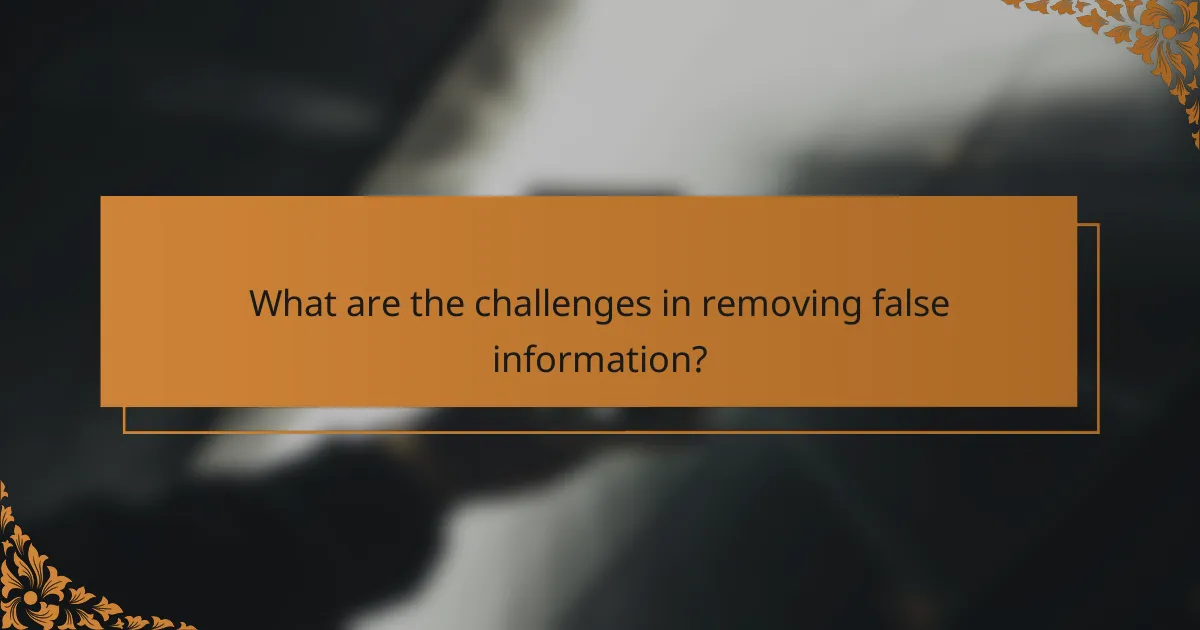
What are the challenges in removing false information?
Removing false information can be difficult due to the need to prove harm and navigate jurisdictional complexities. These challenges often hinder individuals and organizations from effectively addressing misinformation online.
Proving harm or damage
To successfully remove false information, one must demonstrate that it has caused actual harm or damage. This could include financial losses, reputational damage, or emotional distress. Gathering evidence, such as testimonials or financial records, can strengthen a case.
In many legal systems, the burden of proof lies with the individual seeking removal. This means that vague claims may not suffice; specific instances of harm must be documented. For example, if false information led to lost business opportunities, detailed accounts of those losses are essential.
Jurisdictional issues
Jurisdictional issues arise when false information is published across different regions or countries. Different laws apply in various jurisdictions, which can complicate the process of removal. Understanding where the content is hosted and where the affected party resides is crucial.
For instance, if false information is posted on a website based in another country, the legal framework for addressing it may differ significantly from local laws. This can lead to delays or even failures in obtaining relief. Consulting with legal experts familiar with international law can help navigate these complexities effectively.
